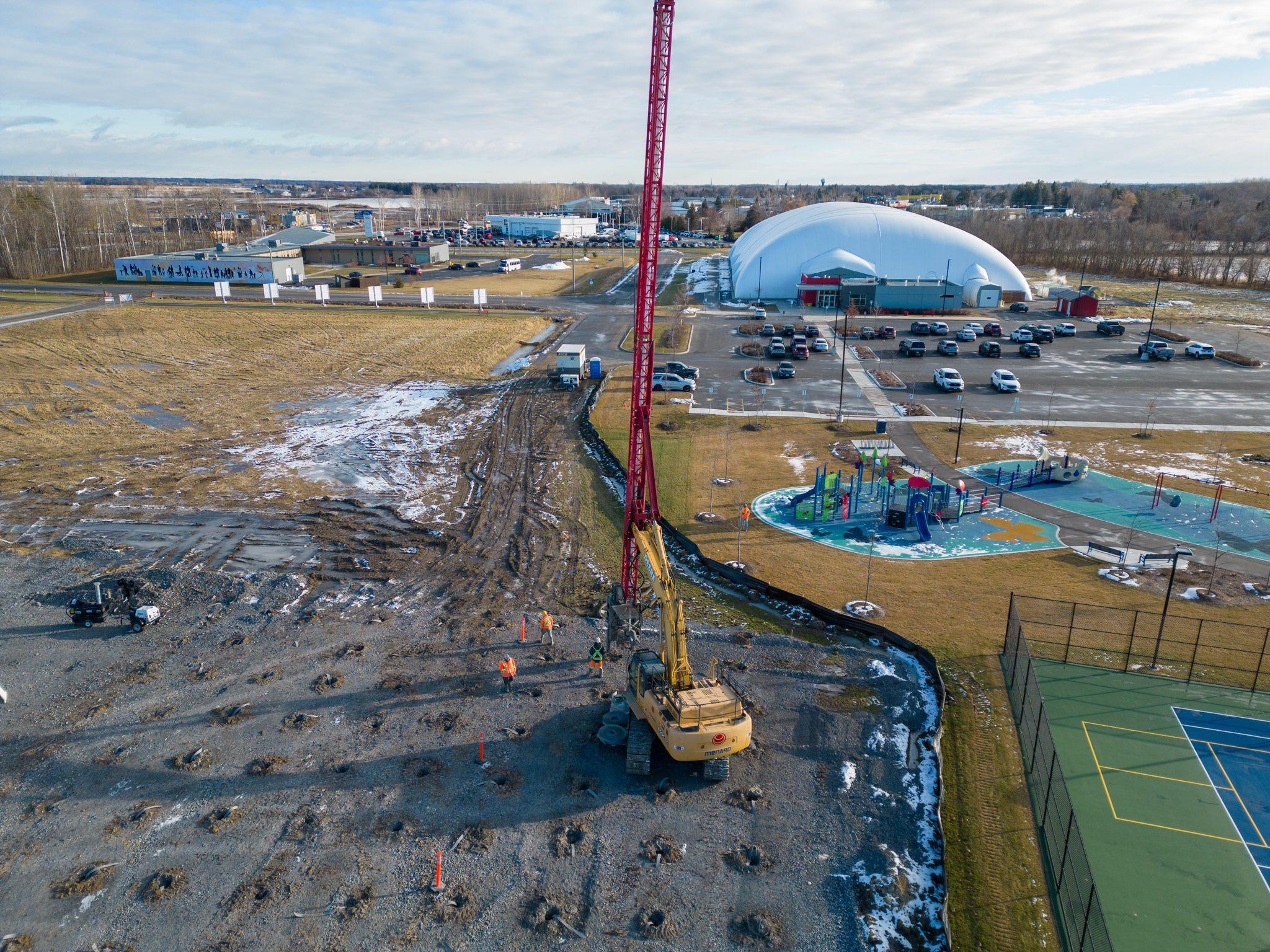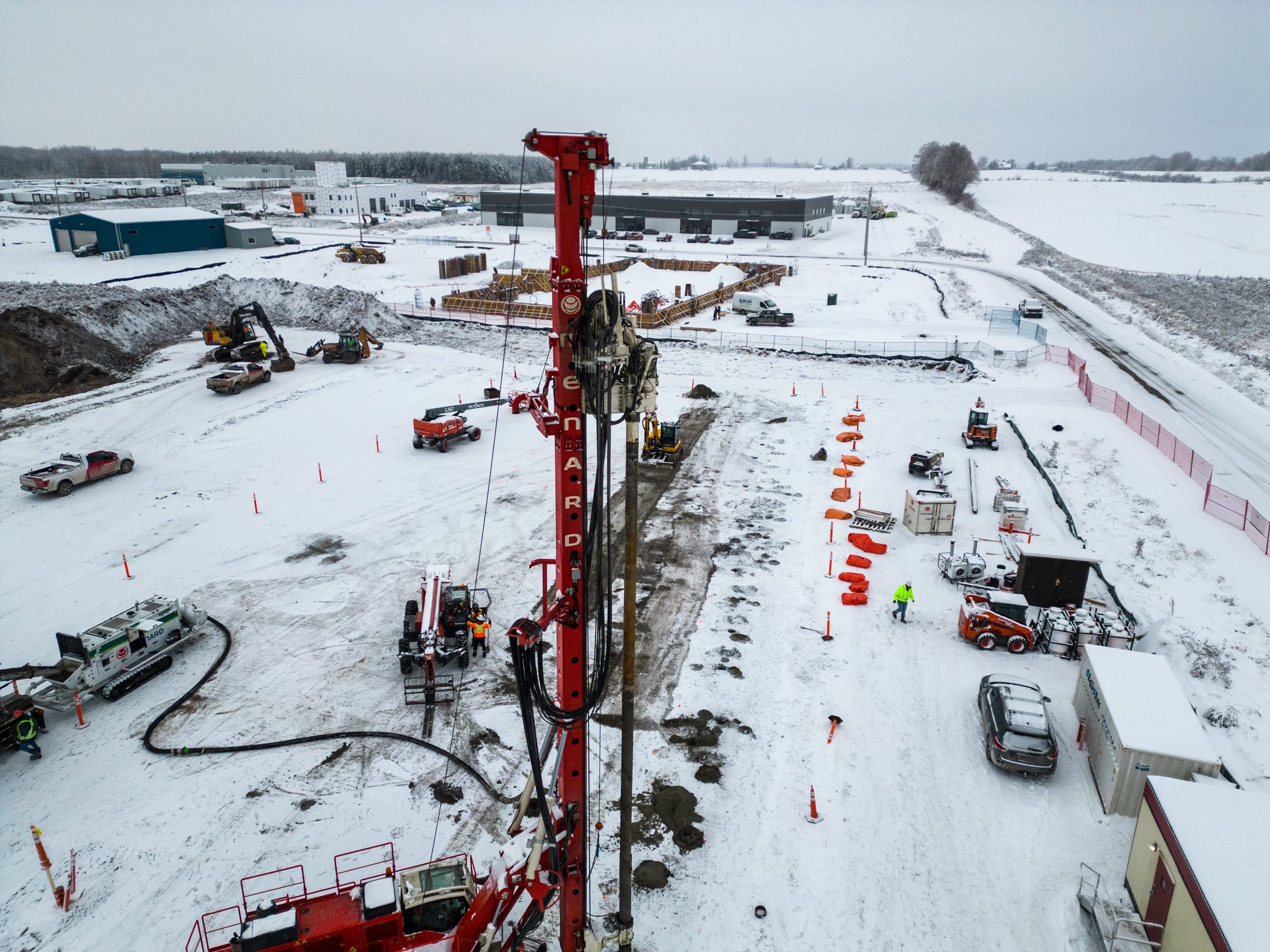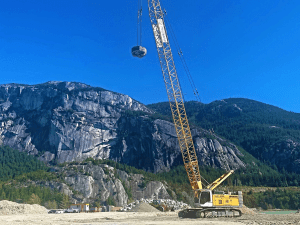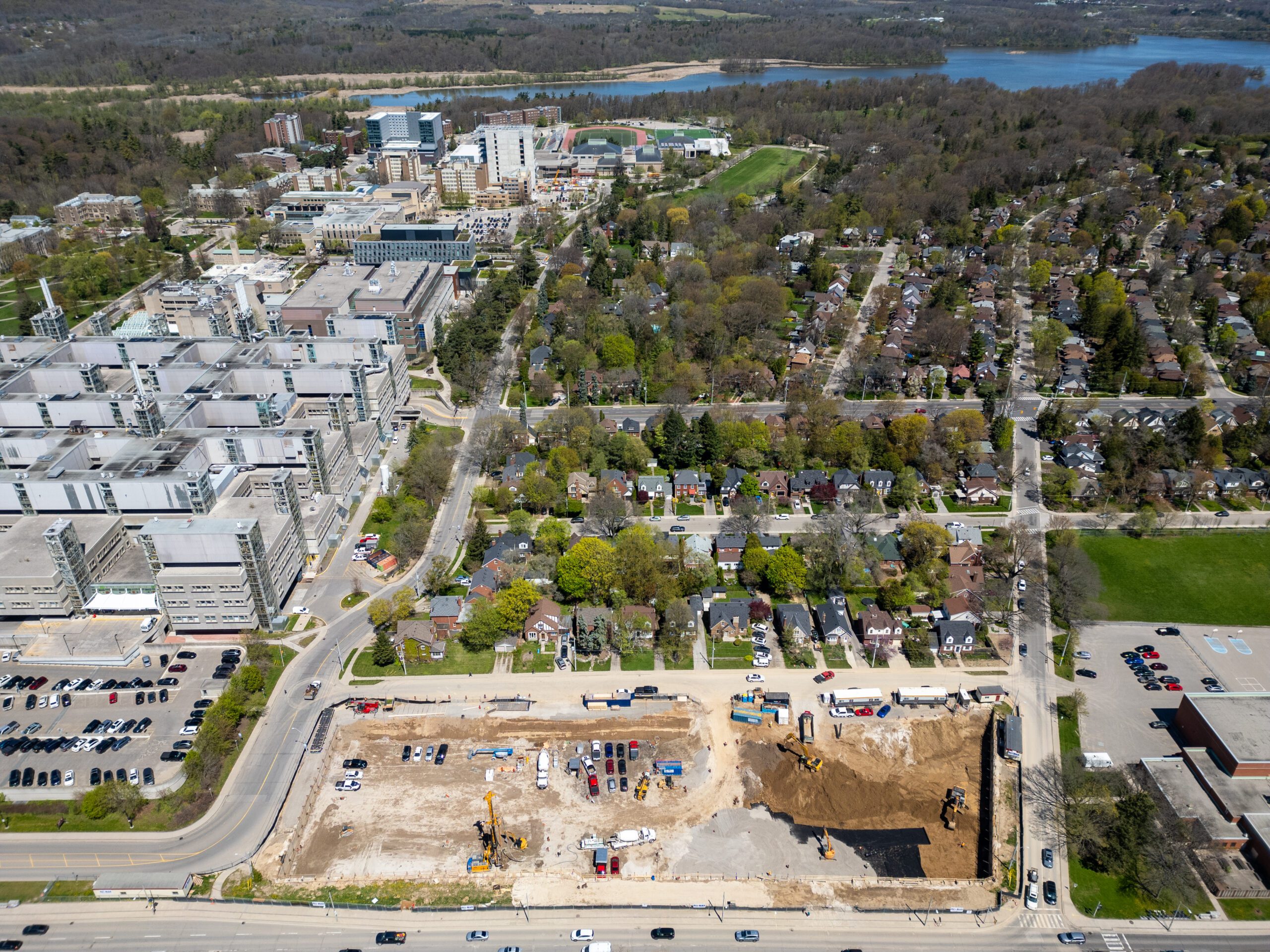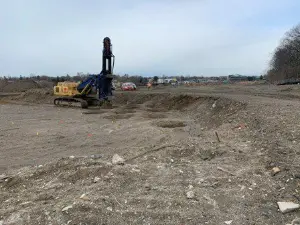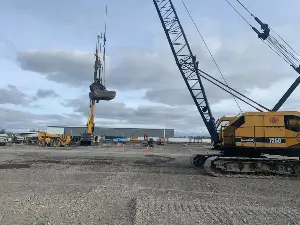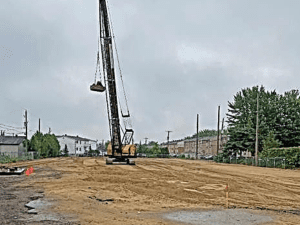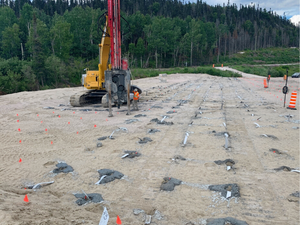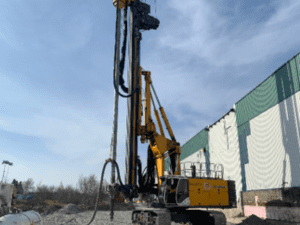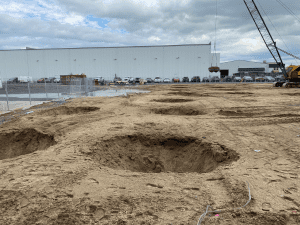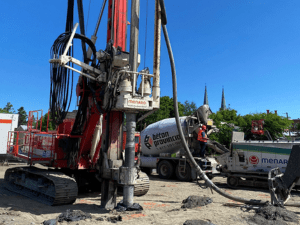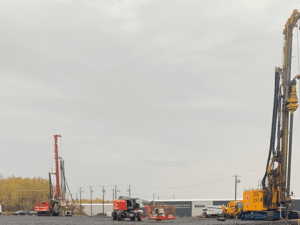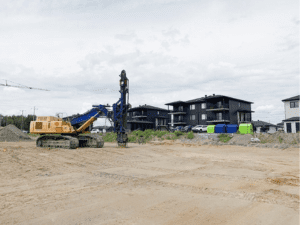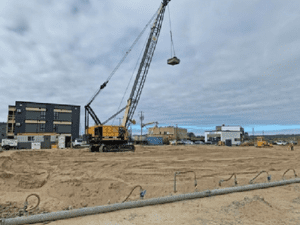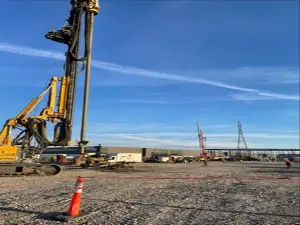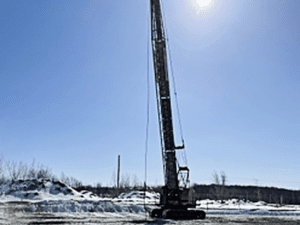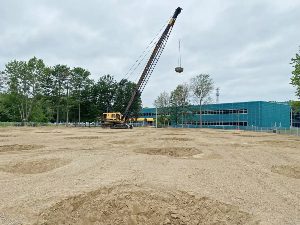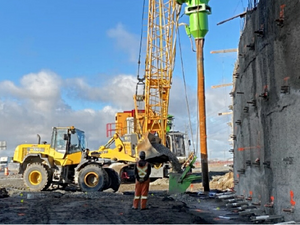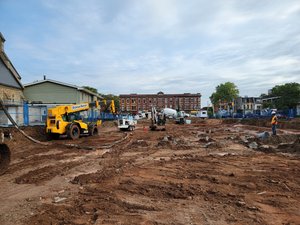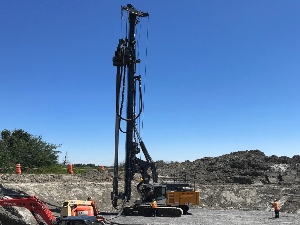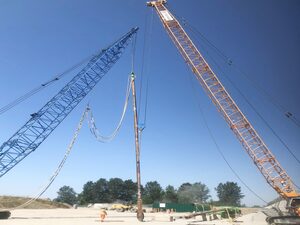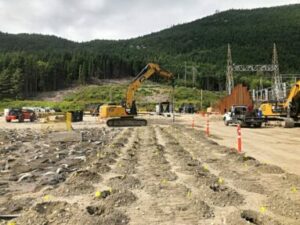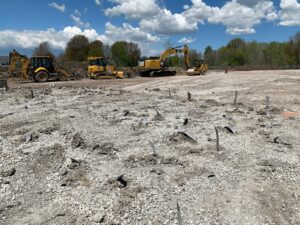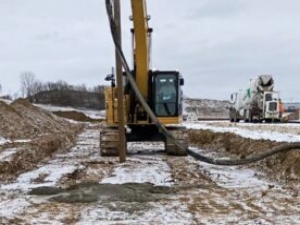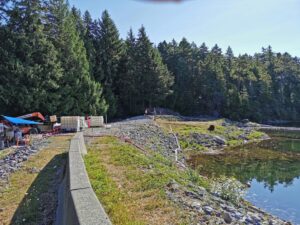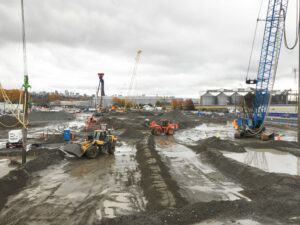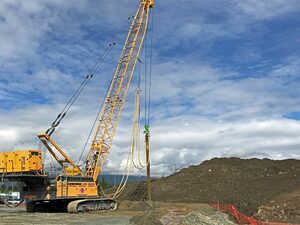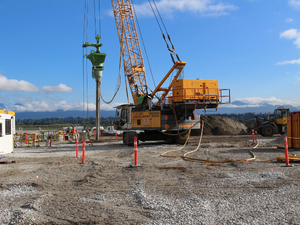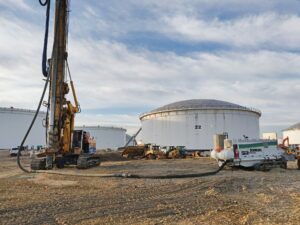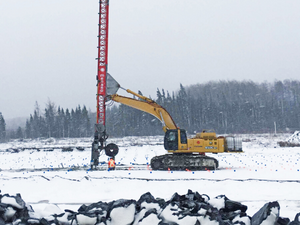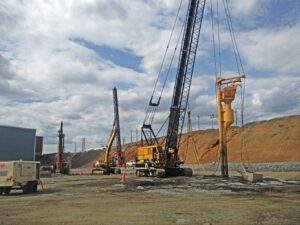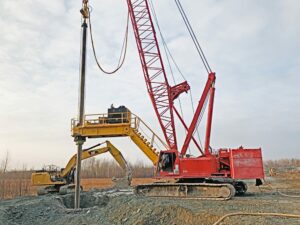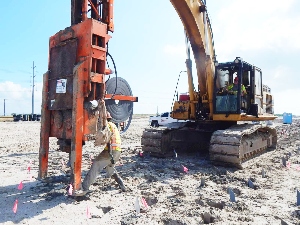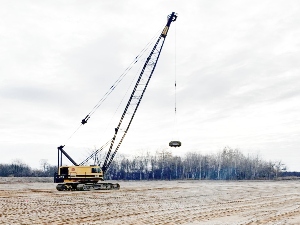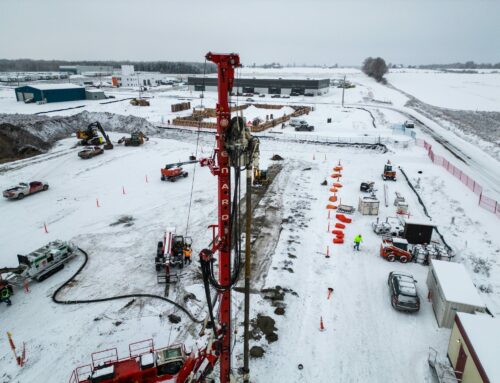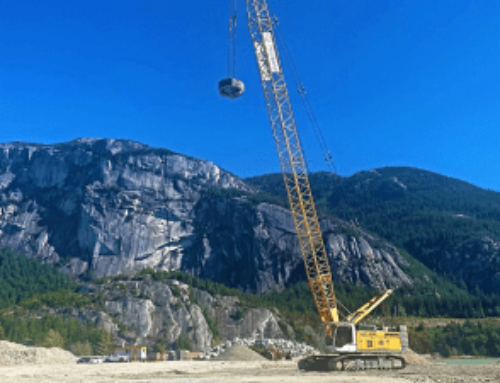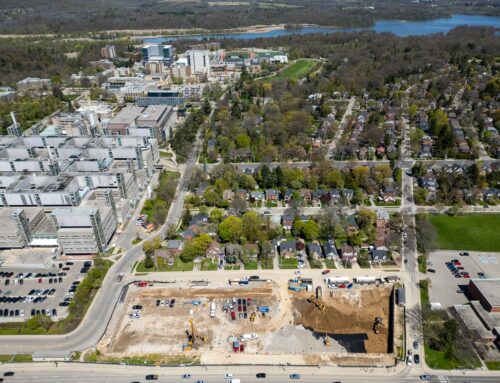Selected Techniques:
Deep Soil Mixing
Stone Columns
Treatment Area:
9,050m²
Project Depth:
10-18m
Menard Canada was approached to improve the stability of the dam slopes for the Kiena gold mine, located in Val d’Or, Qc. The main aim of this project is to increase the Factor of Safety (FoS) of the upstream and downstream dams for the static forces, permeability and rapid drainage occurring during or after an earthquake event.
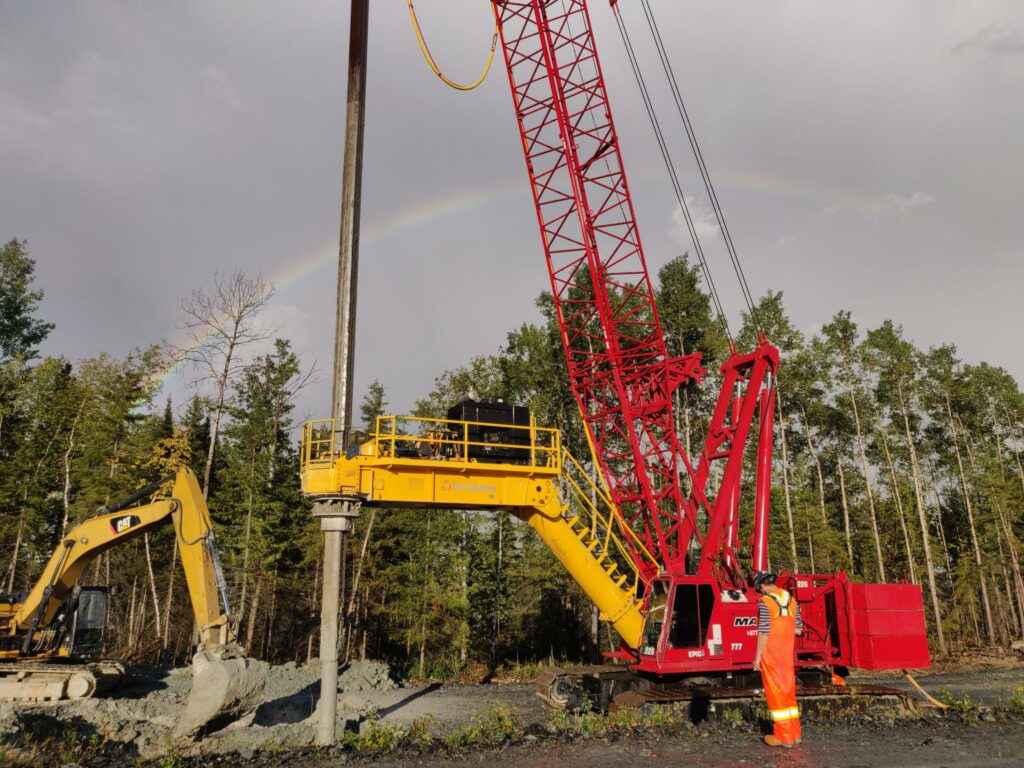
Wesdome Kiena Mine, Val d’Or, Québec
Ground Conditions
The natural stratigraphy present in and around the Kiena Mine TSF consists of:
- Overlain Sensitive Varve Clay extending from 5 to 15m depending on the location of the dyke
- A thin lens of Clayey Silt with traces of Sand for 3 to 4m below
- Overlying cobbles and boulder that makes up the till layer
Menard Canada Solution
Menard performed Deep Soil Mixing (DSM) under the dykes to effectively increase the Factor of Safety, Shear Strength, stability, and load-bearing while reducing the permeability of the ground and the liquefaction. Deep Soil Mixing uses a unique tool for in situ mechanical mixing of the soil with binder through a process that simultaneously breaks down the soil without extraction and injects a binder at low pressure to create columns or panels of reinforced soil. The project is designed to divide the entire dyke area into equally spaced panels, each comprising three/four overlapping DSM columns. This effectively creates a shear wall whose overall strength can be varied according to the volume of grout injected and the design mix. During production, Quality control was closely managed by testing the grout samples for Specific gravity and viscosity. In contrast, the DSM composite mix was tested for the Unconfined Compression Strength (UCS) test. Ultimately, the homogeneity of the DSM composite mix was visually confirmed by retrieving Sonic Samples directly from the columns.
Other projects
Russell Recreation Complex – Phases 1 & 2, Ontariojenniferlemarec2025-05-07T20:55:59+02:00
Russell Recreation Complex – Phases 1 & 2, Ontario
Oceanfront Park development, Squamish, British ColumbiaMenard Canada2024-07-31T22:48:15+02:00
Oceanfront Park development, Squamish, British Columbia
Student Residence, Mc Master University: Hamilton, OntarioMenard Canada2025-06-20T17:23:44+02:00
Student Residence, Mc Master University: Hamilton, Ontario
Birchley Park, Residential Housing – Toronto, Ontariomenardcanadainc2024-07-22T20:44:36+02:00
Birchley Park, Residential Housing – Toronto, Ontario
Metro Warehouse: Terrebonne, Québecmenardcanadainc2024-07-22T20:11:13+02:00
Metro Warehouse: Terrebonne, Québec
Multi-Housing: Saint-Charles-Borromée, QuébecMenard Canada2023-11-16T16:23:02+01:00
Multi-Housing: Saint-Charles-Borromée, Québec
Residential Housing: Répentigny QuébecMenard Canada2023-09-19T22:26:33+02:00
Residential Housing: Répentigny Québec
Rosefellow Industrial Building: Beauharnois, QuébecMenard Canada2023-10-24T22:12:34+02:00
Rosefellow Industrial Building: Beauharnois, Québec
Manufacturing Facility: Val d’Or, QuébecMenard Canada2023-11-16T18:07:54+01:00
Manufacturing Facility: Val d’Or, Québec
Fruit d’Or Processing Plant: Plessisville, QuébecMenard Canada2023-11-16T17:31:01+01:00
Fruit d’Or Processing Plant: Plessisville, Québec
Residence: Sainte-Anne-des-Monts, QuébecMenard Canada2023-11-15T21:38:08+01:00
Residence: Sainte-Anne-des-Monts, Québec
Communications Tower-Videotron: Rigaud, QuébecMenard Canada2023-09-19T22:41:59+02:00
Communications Tower-Videotron: Rigaud, Québec
Warehouse CANAC: Saint-Nicolas, QuébecMenard Canada2023-11-16T17:34:59+01:00
Warehouse CANAC: Saint-Nicolas, Québec
Commercial Buildings: Pont Rouge, QuébecMenard Canada2023-09-19T20:12:30+02:00
Commercial Buildings: Pont Rouge, Québec
Residential Housing: Trois-Rivières, QuébecMenard Canada2023-11-16T17:05:19+01:00
Residential Housing: Trois-Rivières, Québec
Acéricole Warehouse: Plessisville, QuébecMenard Canada2024-07-22T19:58:00+02:00
Acéricole Warehouse: Plessisville, Québec
Multiuse Building: Laval, QuébecMenard Canada2023-09-19T20:07:24+02:00
Multiuse Building: Laval, Québec
Government Buildings: Shawinigan, QuébecMenard Canada2024-07-22T20:40:59+02:00
Government Buildings: Shawinigan, Québec
Manufacturing Plant, Innomalt: Bécancour, QuébecMenard Canada2023-11-15T20:54:23+01:00
Manufacturing Plant, Innomalt: Bécancour, Québec
Oceanfront Park Phase A: Squamish, British Columbiamenardcanadainc2023-11-16T16:20:28+01:00
Oceanfront Park Phase A: Squamish, British Columbia
Waste Water Treatment Plant: Vancouver, British Columbiamenardcanadainc2023-11-23T10:58:52+01:00
Waste Water Treatment Plant: Vancouver, British Columbia
CP Rail, Coquitlam: British Columbiamenardcanadainc2023-05-02T22:47:42+02:00
CP Rail, Coquitlam: British Columbia
Highway 91-17: Delta, British Columbiamenardcanadainc2023-05-02T22:48:59+02:00
Highway 91-17: Delta, British Columbia
West Calgary Ring Road: Calgary, Albertamenardcanadainc2023-11-16T16:16:17+01:00
West Calgary Ring Road: Calgary, Alberta
Road 389 Upgrade: Baie Comeau, Québecmenardcanadainc2023-05-02T22:51:07+02:00
Road 389 Upgrade: Baie Comeau, Québec
Deltaport Facility: Delta British Colombiamenardcanadainc2023-11-16T17:10:59+01:00
Deltaport Facility: Delta British Colombia
Maison des Aînés: Alma, Québecmenardcanadainc2023-11-16T16:55:50+01:00
Maison des Aînés: Alma, Québec
School Building: Hamilton, Ontariomenardcanadainc2023-05-02T22:55:59+02:00
School Building: Hamilton, Ontario
Val-ÉO Wind Turbines: St-Gédéon, QuébecMenard Canada2023-11-16T17:21:01+01:00
Val-ÉO Wind Turbines: St-Gédéon, Québec
Warehouse: Sorel-Tracy, Québecmenardcanadainc2023-11-16T18:12:02+01:00
Warehouse: Sorel-Tracy, Québec
Dike Upgrades: Delta, British ColumbiaMenard Canada2023-05-02T23:02:38+02:00
Dike Upgrades: Delta, British Columbia
U of T Student Residence: Toronto, Ontariomenardcanadainc2023-11-15T21:25:40+01:00
U of T Student Residence: Toronto, Ontario
Minette Substation: Kitimat, British ColumbiaMenard Canada2023-11-15T21:50:00+01:00
Minette Substation: Kitimat, British Columbia
Hydro One Operations: Dunnville, OntarioMenard Canada2023-05-02T23:07:05+02:00
Hydro One Operations: Dunnville, Ontario
Evolution Mining: Red Lake, OntarioMenard Canada2023-11-16T17:16:48+01:00
Evolution Mining: Red Lake, Ontario
Fraser Surrey Docks: Surrey, British Columbiamenardcanadainc2024-05-20T21:53:43+02:00
Fraser Surrey Docks: Surrey, British Columbia
Industrial Building: Brantford, OntarioMenard Canada2023-05-02T23:10:05+02:00
Industrial Building: Brantford, Ontario
Residential Development: Toronto, Ontariomenardcanadainc2023-05-02T22:45:02+02:00
Residential Development: Toronto, Ontario
Dam No. 5: Vancouver Island, British ColumbiaMenard Canada2023-05-02T22:43:18+02:00
Dam No. 5: Vancouver Island, British Columbia
Dike Upgrade: New Westminster, British ColumbiaMenard Canada2023-05-02T22:41:05+02:00
Dike Upgrade: New Westminster, British Columbia
Hotel Development: Thunder Bay, Ontariomenardcanadainc2023-05-02T22:38:38+02:00
Hotel Development: Thunder Bay, Ontario
Drainage Pump Station Upgrade: Vancouver, British ColumbiaMenard Canada2023-11-16T16:26:11+01:00
Drainage Pump Station Upgrade: Vancouver, British Columbia
Residential Subdivision: Whitby, Ontariomenardcanadainc2023-11-16T17:00:59+01:00
Residential Subdivision: Whitby, Ontario
Water Treatment Plant: Chilliwack, British ColumbiaMenard Canada2023-11-15T21:35:16+01:00
Water Treatment Plant: Chilliwack, British Columbia
Pumping Station: Richmond, British ColumbiaMenard Canada2023-11-15T21:36:30+01:00
Pumping Station: Richmond, British Columbia
YVR Airport: Richmond, British Colombiamenardcanadainc2025-09-10T20:05:43+02:00
YVR Airport: Richmond, British Colombia
Trans Mountain Expansion Project: Edmonton, AlbertaMenard Canada2023-11-15T21:42:22+01:00
Trans Mountain Expansion Project: Edmonton, Alberta
Canadian Malartic Mine: Malartic, Québecmenardcanadainc2023-11-16T16:43:20+01:00
Canadian Malartic Mine: Malartic, Québec
Whale Tail Dike: Amaruq, Nunavutmenardcanadainc2023-10-09T23:58:39+02:00
Whale Tail Dike: Amaruq, Nunavut
VALE Nickel Mines: Sudbury, Ontariomenardcanadainc2023-11-16T16:35:09+01:00
VALE Nickel Mines: Sudbury, Ontario
Wesdome Kiena Mine: Val d’or, Québecmenardcanadainc2023-11-23T11:25:17+01:00
Wesdome Kiena Mine: Val d’or, Québec
Hydro One Storage Facility: Dunnville, OntarioMenard Canada2023-05-02T22:14:22+02:00
Hydro One Storage Facility: Dunnville, Ontario
Industrial Building: Bécancour QuébecMenard Canada2023-05-02T22:06:47+02:00

